
Boysenberries are a delicious and unique fruit that often gets overlooked. Have you ever wondered what makes this berry so special? Boysenberries are a cross between raspberries, blackberries, and loganberries, creating a sweet yet tangy flavor. They were first cultivated by Rudolph Boysen in the 1920s. These berries are not only tasty but also packed with nutrients like vitamin C, fiber, and antioxidants. Boysenberries thrive in warm climates and are typically harvested in late spring to early summer. Whether you enjoy them fresh, in jams, or baked into pies, boysenberries offer a delightful treat. Ready to learn more? Let's dive into 20 fascinating facts about boysenberries that will make you appreciate this fruit even more!
Key Takeaways:
- Boysenberries are a unique hybrid fruit with a rich history and a delicious sweet-tart flavor. They are packed with nutrients, low in calories, and perfect for making jams, pies, and syrups.
- If you want to grow boysenberries, remember they prefer mild climates, need support for their thorny canes, and require regular monitoring for diseases. In the kitchen, they are versatile for making jams, pies, smoothies, syrups, and for fresh eating.
What is a Boysenberry?
Boysenberries are a unique fruit with a rich history and fascinating characteristics. They are a hybrid berry, combining the best traits of raspberries, blackberries, and loganberries. Let's dive into some intriguing facts about this delicious fruit.
-
Hybrid Origin: Boysenberries are a cross between raspberries, blackberries, and loganberries. This hybridization gives them a unique flavor profile.
-
Named After Rudolph Boysen: The berry is named after Rudolph Boysen, who first created the hybrid in the 1920s.
-
California Roots: Boysenberries were first commercially cultivated in California, thanks to the efforts of Walter Knott of Knott's Berry Farm.
-
Deep Purple Color: When ripe, boysenberries have a deep purple color, almost black, which indicates their rich antioxidant content.
-
Sweet and Tart Flavor: The flavor of boysenberries is a perfect balance of sweet and tart, making them a favorite for jams, pies, and syrups.
Nutritional Benefits of Boysenberries
Boysenberries are not only tasty but also packed with nutrients. Here are some health benefits you can gain from consuming them.
-
Rich in Vitamin C: Boysenberries are an excellent source of vitamin C, which helps boost the immune system.
-
High in Fiber: These berries are high in dietary fiber, aiding in digestion and promoting a healthy gut.
-
Antioxidant Powerhouse: Boysenberries contain high levels of antioxidants, which help combat free radicals in the body.
-
Low in Calories: Despite their sweet taste, boysenberries are low in calories, making them a healthy snack option.
-
Good Source of Vitamin K: They provide a good amount of vitamin K, essential for blood clotting and bone health.
Growing Boysenberries
Interested in growing your own boysenberries? Here are some facts about their cultivation.
-
Thorny Canes: Boysenberry plants have thorny canes, so be careful when handling them.
-
Prefers Mild Climates: They thrive in mild climates with plenty of sunshine and well-drained soil.
-
Requires Trellising: Boysenberry plants need support, such as a trellis, to grow properly and produce fruit.
-
Prone to Disease: These plants can be susceptible to diseases like powdery mildew and verticillium wilt, so regular monitoring is essential.
-
Harvest Season: Boysenberries are typically harvested in late spring to early summer, depending on the climate.
Culinary Uses of Boysenberries
Boysenberries are versatile in the kitchen. Here are some popular ways to use them.
-
Jams and Jellies: Their sweet-tart flavor makes boysenberries perfect for making jams and jellies.
-
Pies and Tarts: Boysenberries are a popular filling for pies and tarts, offering a delicious and unique taste.
-
Smoothies: Add boysenberries to smoothies for a burst of flavor and nutrition.
-
Syrups: Boysenberry syrup is a favorite topping for pancakes, waffles, and ice cream.
-
Fresh Eating: Of course, boysenberries can be enjoyed fresh, straight from the vine, for a healthy and tasty treat.
Boysenberry: A Berry Worth Knowing
Boysenberries aren't just tasty; they're packed with vitamins and antioxidants. These berries, a mix of raspberry, blackberry, loganberry, and dewberry, offer a unique flavor. Originating from California, they thrive in mild climates. Rich in fiber, they aid digestion and support heart health. Boysenberries also boost the immune system thanks to their high vitamin C content. They can be enjoyed fresh, in jams, or as a dessert topping. Though not as common as other berries, their distinct taste makes them special. If you haven't tried boysenberries yet, you're missing out on a delicious and nutritious treat. So next time you're at the market, grab some and enjoy the benefits of this amazing berry.
Frequently Asked Questions
Was this page helpful?
Our commitment to delivering trustworthy and engaging content is at the heart of what we do. Each fact on our site is contributed by real users like you, bringing a wealth of diverse insights and information. To ensure the highest standards of accuracy and reliability, our dedicated editors meticulously review each submission. This process guarantees that the facts we share are not only fascinating but also credible. Trust in our commitment to quality and authenticity as you explore and learn with us.


